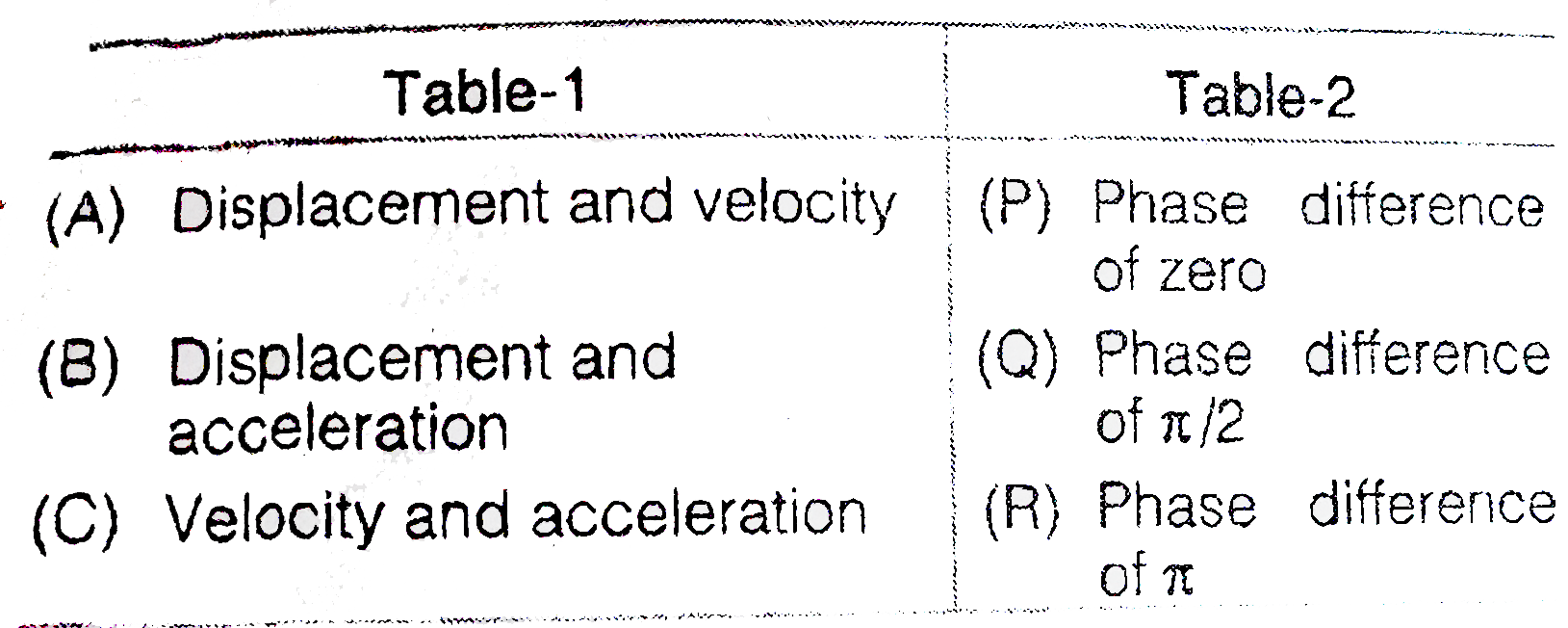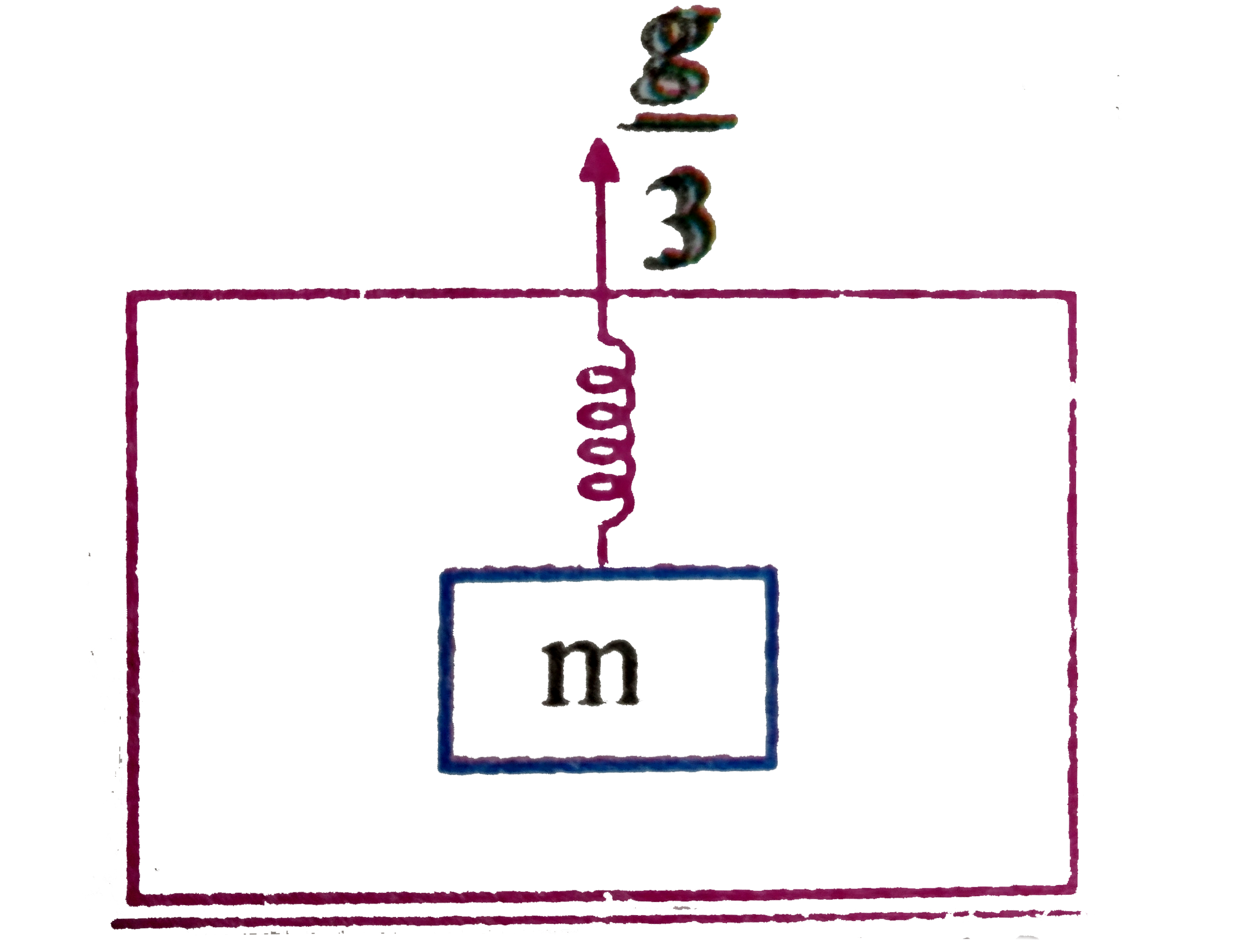A 2kg block hangs without vibrating at the bottom end of a spring with a force constant of 400N/m. The top end of the spring is attached to the ceiling of an elevator car. The car is rising with an upward acceleration of 5m/s2 when the acceleration suddenly ceases at time t=0 and the car moves upward with constant speed (g=10m/s2 The amplitude of the oscillation is
The correct Answer is:D
To solve the problem step by step, we need to analyze the forces acting on the block when the elevator is accelerating and then when it moves with constant speed.
Step 1: Understand the forces acting on the block
When the elevator is accelerating upwards, the effective force acting on the block is the sum of the gravitational force and the force due to the elevator's acceleration. The gravitational force acting on the block is given by:
Fg=m⋅g
where m=2kg and g=10m/s2.
Step 2: Calculate the gravitational force
Fg=2kg⋅10m/s2=20N
Step 3: Calculate the effective force when the elevator is accelerating
The effective force acting on the block when the elevator is accelerating upwards with an acceleration a=5m/s2 is:
Feffective=Fg+Fa=m⋅g+m⋅a
Feffective=20N+2kg⋅5m/s2=20N+10N=30N
Step 4: Relate the effective force to the spring constant
According to Hooke's law, the force exerted by the spring is:
Fs=k⋅x0
where k=400N/m and x0 is the extension of the spring when the block is at rest.
Setting the effective force equal to the spring force:
k⋅x0=Feffective
400N/m⋅x0=30N
Step 5: Solve for x0
x0=30N400N/m=0.075m
Step 6: Determine the amplitude of oscillation
The amplitude of oscillation is equal to the extension of the spring when the elevator was accelerating upwards. Thus, the amplitude A is:
A=x0=0.075m=7.5cm
Final Answer
The amplitude of the oscillation is 7.5cm.
---
When the elevator is accelerating upwards, the effective force acting on the block is the sum of the gravitational force and the force due to the elevator's acceleration. The gravitational force acting on the block is given by:
Fg=m⋅g
where m=2kg and g=10m/s2.
Fg=2kg⋅10m/s2=20N
The effective force acting on the block when the elevator is accelerating upwards with an acceleration a=5m/s2 is:
Feffective=Fg+Fa=m⋅g+m⋅a
Feffective=20N+2kg⋅5m/s2=20N+10N=30N
According to Hooke's law, the force exerted by the spring is:
Fs=k⋅x0
where k=400N/m and x0 is the extension of the spring when the block is at rest.
k⋅x0=Feffective
400N/m⋅x0=30N
x0=30N400N/m=0.075m
The amplitude of oscillation is equal to the extension of the spring when the elevator was accelerating upwards. Thus, the amplitude A is:
A=x0=0.075m=7.5cm
The amplitude of the oscillation is 7.5cm.
Topper's Solved these Questions
- SIMPLE HARMONIC MOTIONBOOK - DC PANDEY ENGLISHCHAPTER - SIMPLE HARMONIC MOTIONEXERCISE - Comprehension types
18 Videos
- SIMPLE HARMONIC MOTIONBOOK - DC PANDEY ENGLISHCHAPTER - SIMPLE HARMONIC MOTIONEXERCISE - Matrix matching type questions
13 Videos
- SIMPLE HARMONIC MOTIONBOOK - DC PANDEY ENGLISHCHAPTER - SIMPLE HARMONIC MOTIONEXERCISE - JEE Advanced
34 Videos
- SEMICONDUCTORS AND ELECTRONIC DEVICESBOOK - DC PANDEY ENGLISHCHAPTER - SEMICONDUCTORS AND ELECTRONIC DEVICESEXERCISE - More than One Option is Correct
3 Videos
- SOLVD PAPERS 2017 NEET, AIIMS & JIPMERBOOK - DC PANDEY ENGLISHCHAPTER - SOLVD PAPERS 2017 NEET, AIIMS & JIPMEREXERCISE - Solved paper 2018(JIPMER)
38 Videos
Similar Questions
Passage I) In simple harmonic motion force acting on a particle is given as F=−4x, total mechanical energy of the particle is 10 J and amplitude of oscillations is 2m, At time t=0 acceleration of the particle is −16ms2. Mass of the particle is 0.5 kg.
Potential energy of the particle at mean position is
View SolutionIn SHM, match the following.

View SolutionA particle moves such that its acceleration is given by a=−β(x−2)
Here, β is a positive constnt and x the x-coordinate with respect to the origin. Time period of oscillation is
View SolutionWhen an electric field is applied across a semiconductor,
View SolutionIf a machine perform 4000 J output work and 1000 J is inside loss due to friction , then the find efficiency?
View SolutionA block with a mass of 2kg hangs without vibrating at the end of a spring of spring constant 500N/m, which is attached to the ceiling of an elevator. The elevator is moving upwards with an acceleration g3. At time t=0, the acceleration suddenly ceases.
(a) What is the angular frequency of oscillation of the block after the acceleration ceases ?
(b) By what amount is the spring stretched during the time when the elevator is accelerating ?
(c )What is the amplitude of oscillation and initial phase angle observed by a rider in the elevator in the equation, x=Asin(ωt+ϕ) ? Take the upward direction to be positive. Take g=10.0m/s2.
View SolutionA 2kg block hangs without vibrating at the bottom end of a spring with a force constant of 400 N//m . The top end of the spring is attached to the ceiling of an elevator car. The car is rising with an upward acceleration of 5 m//s^(2) when the acceleration suddenly ceases at time t = 0 and the car moves upward with constant speed (g = 10 m//s^(2)) What is the angular frequencyof the block after the acceleration ceases ?
View SolutionA 2kg block hangs without vibrating at the bottom end of a spring with a force constant of 400 N//m . The top end of the spring is attached to the ceiling of an elevator car. The car is rising with an upward acceleration of 5 m//s^(2) when the acceleration suddenly ceases at time t = 0 and the car moves upward with constant speed (g = 10 m//s^(2) The amplitude of the oscillation is
View SolutionA spring of spring constant 200N/m has a block of mass 1kg hanging at its one end and form the other and the spring is attached to a celling of an elevator. The elevator rises upwards with an acceleration of g/3.
When acceleration is suddenly ceased , then what should be the angular frequency and elongation during the time when the elevator is accelerating?

View SolutionA block of mass 1kg hangs without vibrating at the end of a spring whose force constant is 200(N)/(m) and which is attached to the ceiling of an elevator. The elevator is rising with an upward acceleration of (g)/(3) when the acceleration suddenly ceases. The angular frequency of the block after the acceleration ceases is
View SolutionA spring of spring constant 200N/m has a block of mass 1kg hanging at its one end and other end of spring is attached to ceiling of an elevator. The elevator is rising upwards with an acceleration g/3. What should be the angular frequency and elongation during the time when the elevator is accelerating?

View SolutionPassage X) A 2kg block hangs without vibrating at the bottom end of a spring with a force constant of 400 N/m. The top end of the spring is attached to the ceiling of an elevator car. The car is rising with an upward acceleration of 5ms^(2)whenthea≤rationsuddenlyceasesatt=0andthecarmovesupwardwithconstantspeed.(g=10ms^(2))
What is the angular frequency of oscillation of the block after the acceleration ceases?
View SolutionPassage X) A 2kg block hangs without vibrating at the bottom end of a spring with a force constant of 400 N/m. The top end of the spring is attached to the ceiling of an elevator car. The car is rising with an upward acceleration of 5m/ s^(2) when the accleration suddenly ceases at t=0 and the car moves upward with constant speed. (g=10m/ s^(2) ) The amplitude of the osciallations is
View SolutionPassage X) A 2kg block hangs without vibrating at the bottom end of a spring with a force constant of 400 N/m. The top end of the spring is attached to the ceiling of an elevator car. The car is rising with an upward acceleration of 5m/ s^(2) when the accleration suddenly ceases at t=0 and the car moves upward with constant speed. (g=10m/ s^(2) ) The initial phase angle observed by a rider in the elevator, taking upward directioin to be positive and positive extreme position to have pi/2 phase constant, is equal to
View SolutionA block of mass 1kg hangs without vibrations at the end of a spring with a force constant 1N/m attached to the ceilling of an elevator. The elevator is rising with an upward acceleration of g/4. The acceleration of the elevator suddenly ceases. What is the amplitude of the resulting oscillations?
View Solution
